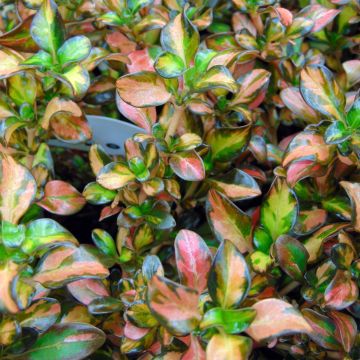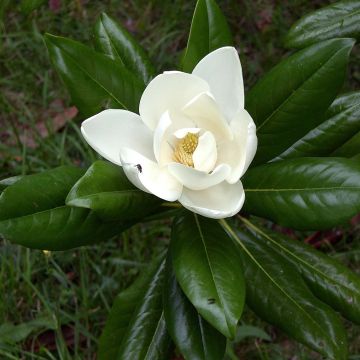

Fargesia Malachite Monkeys - Non-running bamboo
Fargesia Malachite Monkeys - Non-running bamboo
Fargesia Malachite Monkeys ®
Good size for this bamboo. Missing a lot of leaves at the bottom but I think it's due to the transportation. We'll see.
Patrick_B, 12/11/2024
Special offer!
Receive a €20 voucher for any order over €90 (excluding delivery costs, credit notes, and plastic-free options)!
1- Add your favorite plants to your cart.
2- Once you have reached €90, confirm your order (you can even choose the delivery date!).
3- As soon as your order is shipped, you will receive an email containing your voucher code, valid for 3 months (90 days).
Your voucher is unique and can only be used once, for any order with a minimum value of €20, excluding delivery costs.
Can be combined with other current offers, non-divisible and non-refundable.
Home or relay delivery (depending on size and destination)
Schedule delivery date,
and select date in basket
This plant carries a 24 months recovery warranty
More information
We guarantee the quality of our plants for a full growing cycle, and will replace at our expense any plant that fails to recover under normal climatic and planting conditions.
Would this plant suit my garden?
Set up your Plantfit profile →
Description
Fargesia Malachite Monkeys is a non-running, compact bamboo that is easy to grow. This variety is particularly appreciated for creating low hedges that can be shaped into squares, as well as topiaries in pots, in the form of spheres, cubes, or cones. Its foliage is truly captivating, with very small leaves in a beautiful green shade reminiscent of malachite. Its dense vegetation is a definite asset for creating superb clumps, either as standalone plants or in containers. Hardy and adaptable, it can thrive in most ordinary soils, in sunny or partially shaded locations.
Fargesia is a plant belonging to the Poaceae family, formerly known as Gramineae. It produces woody stems that develop from a non-running rhizomatous rootstock, known as clumping. In this type of bamboo, the rhizomes, which have particularly short internodes, slowly spread at the periphery of the rootstock, gradually widening it, but they also grow towards the centre of the clump, keeping it dense and full. Another great advantage is that there is no risk of being invaded by rhizome shoots far away from the main clump.
This cultivar 'Malachite Monkeys' is a recent horticultural variety from the Well Born Bamboo Africa range, obtained through seed propagation and selection of the best specimens at the turn of the 21st century. Originating from China, it is not expected to flower for at least 90 years, which is reassuring as flowering leads to the death of the plant. The parentage of this seedling bamboo is not clearly established, but its morphology is quite different from that of the typical Fargesia murielae.
This variety is much shorter, if allowed to grow freely. However, this is of little interest as it responds so well to pruning that it would be a shame not to take advantage of it... It forms a very dense clump consisting of multiple slender canes, with a maximum diameter of 10 mm. Adorned with leaves from the ground up, this clump opens up in a V shape towards the top, becoming almost as wide as it is tall. Initially the same green as the foliage, the narrow canes turn brown-purple to black from the second year, with the tips remaining green. The leaf sheaths have a cream to slightly orangish colour and quickly fall to the ground. They leave a somewhat bluish mark on the canes, which fades away after a few weeks.
The leaves are small, measuring approximately 4 cm in length and only 0.5 cm in width. Visually very attractive due to their small size, they are also a beautiful malachite green colour. The canes are very dense and the leaves are numerous and form an opaque curtain when this bamboo is planted as a hedge. When pruned with shears, it can be maintained at a height of 1 to 2 metres (beyond that, it would not be dense enough). When grown in a container, it can easily be shaped with shears to create a superb decorative topiary. The small foliage blends excellently with the limited volume of the plant. Not susceptible to diseases or particular insect sensitivities, this variety can advantageously replace boxwood, which has been attacked by box tree moth for years.
It is very hardy, down to -25°C, and capable of growing in both full sun and shade. It thrives in neutral to acidic soils and can tolerate some limestone. Like its counterparts, it appreciates a certain level of soil moisture, but the soil should be well-drained to prevent waterlogging during heavy rains. It can be planted in full sun, especially in northern regions, or in partial shade further south.
With its unique foliage, this Malachite Monkeys bamboo is attractive for planting as a low hedge or in a pot. Non-invasive and compact, it is perfectly suited for small gardens and contemporary settings. Planted in a beautiful terracotta pot, it will enhance your terrace throughout the year. You can pair it with other small plants to create a welcoming and ornamental scene. For an architectural touch, consider the Bamboo Palm, or Rhapis Excelsa, which is magnificent with its open green fronds and slender dark stems resembling bamboo canes. In colder climates, you will need to protect it during winter, but the rest of the year, what a spectacle! To maintain an exotic theme, Calamondin (Citrus madurensis) will delight you with its small orange fruits in winter. And if you prefer hardy plants, why not try a dwarf fruit tree, such as the Griotella Cherry Tree or the Garden Pearl Pear Tree, both self-fertile and offering delicious fruits...
Report an error about the product description
Fargesia Malachite Monkeys - Non-running bamboo in pictures


Plant habit
Foliage
Botanical data
Fargesia
Malachite Monkeys ®
Poaceae
Cultivar or hybrid
Other Fargesia
View all →Planting and care
Grown in containers, bamboo can be planted at any time of the year, except during freezing temperatures. However, the best planting period is late summer and autumn, when the soil is warm and rainfall is more frequent. The planting distance depends on how you plan to use your bamboo: for a mass planting, allow a spacing of 0.8 to 1 metre between each plant. For a hedge, this distance can be reduced to 0.7 metres for this Malachite Monkeys variety, to achieve a dense and continuous curtain. In general, bamboo prefers rich, well-drained soil that remains moist, either acidic or neutral. It can also tolerate slightly alkaline soil.
During planting, make sure to loosen the soil and moisten the root ball by soaking it in a bucket for fifteen minutes before putting it in the ground. You can also add well-decomposed compost and gently mix it into the surface. Water regularly, especially during the first year in the ground and continuously if your bamboo is grown in a pot. The establishment period may sometimes seem a bit long but don't worry, bamboo needs some time to establish its roots. This variety will then grow 20 to 40 cm per year (each year's canes will be slightly taller than the previous ones).
This bamboo is not invasive, so a rhizome barrier (thick and resistant polypropylene film) is optional.
Aside from pruning twice a year, this bamboo is not demanding: remember to weed around the base, at least during the first few years until its dead leaves form a natural mulch on the ground. An application of nitrogen fertilizer (well-decomposed manure or liquid fertilizer) in spring and autumn can be beneficial.
Planting period
Intended location
Care
-
, onOrder confirmed
Reply from on Promesse de fleurs
Similar products
Haven't found what you were looking for?
Hardiness is the lowest winter temperature a plant can endure without suffering serious damage or even dying. However, hardiness is affected by location (a sheltered area, such as a patio), protection (winter cover) and soil type (hardiness is improved by well-drained soil).

Photo Sharing Terms & Conditions
In order to encourage gardeners to interact and share their experiences, Promesse de fleurs offers various media enabling content to be uploaded onto its Site - in particular via the ‘Photo sharing’ module.
The User agrees to refrain from:
- Posting any content that is illegal, prejudicial, insulting, racist, inciteful to hatred, revisionist, contrary to public decency, that infringes on privacy or on the privacy rights of third parties, in particular the publicity rights of persons and goods, intellectual property rights, or the right to privacy.
- Submitting content on behalf of a third party;
- Impersonate the identity of a third party and/or publish any personal information about a third party;
In general, the User undertakes to refrain from any unethical behaviour.
All Content (in particular text, comments, files, images, photos, videos, creative works, etc.), which may be subject to property or intellectual property rights, image or other private rights, shall remain the property of the User, subject to the limited rights granted by the terms of the licence granted by Promesse de fleurs as stated below. Users are at liberty to publish or not to publish such Content on the Site, notably via the ‘Photo Sharing’ facility, and accept that this Content shall be made public and freely accessible, notably on the Internet.
Users further acknowledge, undertake to have ,and guarantee that they hold all necessary rights and permissions to publish such material on the Site, in particular with regard to the legislation in force pertaining to any privacy, property, intellectual property, image, or contractual rights, or rights of any other nature. By publishing such Content on the Site, Users acknowledge accepting full liability as publishers of the Content within the meaning of the law, and grant Promesse de fleurs, free of charge, an inclusive, worldwide licence for the said Content for the entire duration of its publication, including all reproduction, representation, up/downloading, displaying, performing, transmission, and storage rights.
Users also grant permission for their name to be linked to the Content and accept that this link may not always be made available.
By engaging in posting material, Users consent to their Content becoming automatically accessible on the Internet, in particular on other sites and/or blogs and/or web pages of the Promesse de fleurs site, including in particular social pages and the Promesse de fleurs catalogue.
Users may secure the removal of entrusted content free of charge by issuing a simple request via our contact form.
The flowering period indicated on our website applies to countries and regions located in USDA zone 8 (France, the United Kingdom, Ireland, the Netherlands, etc.)
It will vary according to where you live:
- In zones 9 to 10 (Italy, Spain, Greece, etc.), flowering will occur about 2 to 4 weeks earlier.
- In zones 6 to 7 (Germany, Poland, Slovenia, and lower mountainous regions), flowering will be delayed by 2 to 3 weeks.
- In zone 5 (Central Europe, Scandinavia), blooming will be delayed by 3 to 5 weeks.
In temperate climates, pruning of spring-flowering shrubs (forsythia, spireas, etc.) should be done just after flowering.
Pruning of summer-flowering shrubs (Indian Lilac, Perovskia, etc.) can be done in winter or spring.
In cold regions as well as with frost-sensitive plants, avoid pruning too early when severe frosts may still occur.
The planting period indicated on our website applies to countries and regions located in USDA zone 8 (France, United Kingdom, Ireland, Netherlands).
It will vary according to where you live:
- In Mediterranean zones (Marseille, Madrid, Milan, etc.), autumn and winter are the best planting periods.
- In continental zones (Strasbourg, Munich, Vienna, etc.), delay planting by 2 to 3 weeks in spring and bring it forward by 2 to 4 weeks in autumn.
- In mountainous regions (the Alps, Pyrenees, Carpathians, etc.), it is best to plant in late spring (May-June) or late summer (August-September).
The harvesting period indicated on our website applies to countries and regions in USDA zone 8 (France, England, Ireland, the Netherlands).
In colder areas (Scandinavia, Poland, Austria...) fruit and vegetable harvests are likely to be delayed by 3-4 weeks.
In warmer areas (Italy, Spain, Greece, etc.), harvesting will probably take place earlier, depending on weather conditions.
The sowing periods indicated on our website apply to countries and regions within USDA Zone 8 (France, UK, Ireland, Netherlands).
In colder areas (Scandinavia, Poland, Austria...), delay any outdoor sowing by 3-4 weeks, or sow under glass.
In warmer climes (Italy, Spain, Greece, etc.), bring outdoor sowing forward by a few weeks.


















































